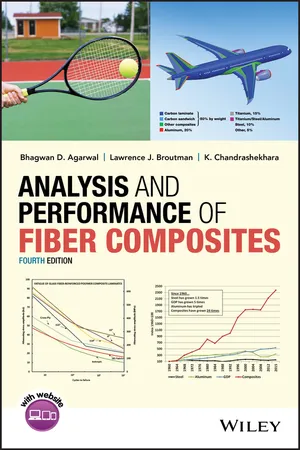
Analysis and Performance of Fiber Composites
- English
- ePUB (mobile friendly)
- Available on iOS & Android
Analysis and Performance of Fiber Composites
About this book
Updated and expanded coverage of the latest trends and developments in fiber composite materials, processes, and applications
Analysis and Performance of Fiber Composites, Fourth Edition features updated and expanded coverage of all technical aspects of fiber composites, including the latest trends and developments in materials, manufacturing processes, and materials applications, as well as the latest experimental characterization methods.
Fiber reinforced composite materials have become a fundamental part of modern product manufacturing. Routinely used in such high-tech fields as electronics, automobiles, aircraft, and space vehicles, they are also essential to everyday staples of modern life, such as containers, piping, and appliances. Little wonder, when one considers their ease of fabrication, outstanding mechanical properties, design versatility, light weight, corrosion and impact resistance, and excellent fatigue strength. This Fourth Edition of the classic reference?the standard text for composite materials courses, worldwide?offers an unrivalled review of such an important class of engineering materials.
Still the most comprehensive, up-to-date treatment of the mechanics, materials, performance, analysis, fabrication, and characterization of fiber composite materials available, Analysis and Performance of Fiber Composites, Fourth Edition features:
- Expanded coverage of materials and manufacturing, with additional information on materials, processes, and material applications
- Updated and expanded information on experimental characterization methods?including many industry specific tests
- Discussions of damage identification techniques using nondestructive evaluation (NDE)
- Coverage of the influence of moisture on performance of polymer matrix composites, stress corrosion of glass fibers and glass reinforced plastics, and damage due to low-velocity impact
- New end-of-chapter problems and exercises with solutions found on an accompanying website
- Computer analysis of laminates
No other reference provides such exhaustive coverage of fiber composites with such clarity and depth. Analysis and Performance of Fiber Composites, Fourth Edition is, without a doubt, an indispensable resource for practicing engineers, as well as students of mechanics, mechanical engineering, and aerospace engineering.
Visit the Companion Website at: https://www.wiley.com/WileyCDA/Section/id-830336.html
Frequently asked questions
- Essential is ideal for learners and professionals who enjoy exploring a wide range of subjects. Access the Essential Library with 800,000+ trusted titles and best-sellers across business, personal growth, and the humanities. Includes unlimited reading time and Standard Read Aloud voice.
- Complete: Perfect for advanced learners and researchers needing full, unrestricted access. Unlock 1.4M+ books across hundreds of subjects, including academic and specialized titles. The Complete Plan also includes advanced features like Premium Read Aloud and Research Assistant.
Please note we cannot support devices running on iOS 13 and Android 7 or earlier. Learn more about using the app.
Information
1
INTRODUCTION
1.1 DEFINITION
1.2 CLASSIFICATION

1.3 PARTICULATE COMPOSITES
Table of contents
- COVER
- TITLE PAGE
- TABLE OF CONTENTS
- PREFACE
- ABOUT THE COMPANION WEBSITE
- 1 INTRODUCTION
- 2 FIBERS, MATRICES, AND FABRICATION OF COMPOSITES
- 3 MICROMECHANICS OF UNIDIRECTIONAL COMPOSITES
- 4 SHORT-FIBER COMPOSITES
- 5 MACROMECHANICS ANALYSIS OF AN ORTHOTROPIC LAMINA
- 6 ANALYSIS OF LAMINATED COMPOSITES
- 7 ANALYSIS OF LAMINATED PLATES AND BEAMS
- 8 ADVANCED TOPICS IN FIBER COMPOSITES
- 9 PERFORMANCE OF FIBER COMPOSITES: FATIGUE, IMPACT, AND ENVIRONMENTAL EFFECTS
- 10 EXPERIMENTAL CHARACTERIZATION OF COMPOSITES
- 11 EMERGING COMPOSITE MATERIALS
- APPINDEX 1: MATRICES AND TENSORS
- APPINDEX 2: EQUATIONS OF THEORY OF ELASTICITY
- APPENDIX 3: LAMINATE ORIENTATION CODE
- APPENDIX 4: PROPERTIES OF FIBER COMPOSITES
- APPENDIX 5: COMPUTER PROGRAMS FOR LAMINATE ANALYSIS
- APPINDEX 6: INTRODUCTION TO MATLAB
- INDEX
- SUPPLEMENTAL IMAGES
- END USER LICENSE AGREEMENT